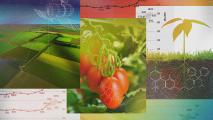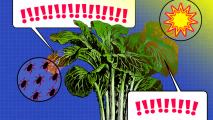Capping off over a decade of work, researchers have succeeded in genetically engineering soybeans to increase the efficiency of their photosynthesis.
The end result is plants that can produce greater yields, without consuming more land or sacrificing the quality of the produce — a potential windfall in the struggle against food scarcity, which the Food and Agriculture Organization (FAO) estimates will impact 660 million people in 2030.
The international Realizing Increased Photosynthetic Efficiency (RIPE) project has been determining how to increase the yield of food crops by optimizing photosynthesis, the process plants use to turn sunlight into energy for growth.
Food scarcity may impact 660 million people by 2030. Better crop yields from optimizing photosynthesis may help prevent it.
After proof-of-concept work in tobacco plants was published in 2016, the team turned their sights to a more difficult task: getting their enhanced photosynthesis to work in food crops.
“Having now shown very substantial yield increases in both tobacco and soybean, two very different crops, suggests this has universal applicability,” Stephen Long, RIPE director and chair of Crop Sciences and Plant Biology at the University of Illinois, said in a statement.
Improving our food supply: The UN cites inefficient food supply chains and increasingly inhospitable climate change as leading factors in food insecurity.
RIPE’s mandate is to improve food security and crop sustainability in impoverished areas by boosting the efficiency of photosynthesis — in particular for small farms in sub-Saharan Africa.
“The number of people affected by food insufficiency continues to grow, and projections clearly show that there needs to be a change at the food supply level to change the trajectory,” Amanda De Souza, study lead author and a RIPE project research scientist, said.
“Our research shows an effective way to contribute to food security for the people who need it most while avoiding more land being put into production. Improving photosynthesis is a major opportunity to gain the needed jump in yield potential.”
Photosynthesis is an attractive target for boosting plant growth because of its inefficiency: per RIPE, it’s an over 100-step process.
“We’ve been looking at photosynthesis and why it might be inefficient for 30 years,” Long told BBC News.
Researchers have genetically engineered soybeans to increase the efficiency of their photosynthesis, creating plants that can produce greater yields, without consuming more land or sacrificing quality.
Improving photosynthesis: To help smooth out that inefficiency, the researchers focused on a specific part of the process.
When plants are exposed to direct, brilliant sunlight, they go into a protective mode, called the “xanthophyll cycle,” which helps them release the extra energy as heat, avoiding damage to their cells.
But when the shade returns, the process needs to be turned off, allowing the plant to photosynthesize with their sunlight reserves. (As The Economist points out, plants are tremendously busy things, despite appearances!) But this takes a while.
“Plants protect themselves from too much sun by dissipating excess light energy,” the researchers wrote in their study, published in Science. “Unfortunately, the switch from dissipating light energy to using light energy for photosynthesis is not as nimble as the clouds moving across the sky.”
Plants can lose a few minutes of photosynthesis every time they need to switch the protective mode off.
The team genetically manipulated three genes that are the blueprints for xanthophyll cycle proteins. In their 2016 study, the team put extra copies of those genes into tobacco plants, which are easy to genetically modify, The Economist reported.
This allowed the plants to more rapidly adjust, increasing their growing time and yields.
By performing a similar trick in the more complex soy plant, the team could get the plant’s protective mode to toggle on and off faster, giving back the extra minutes of photosynthesis. Added up across a growing season, that extra time led to a higher increase in yield.
The study was small and geographically limited; larger studies will need to be conducted to see if their idea holds true.
The team planted eight modified plants in the university’s farm, The Economist reported; five of the eight had greater yields than unmodified control plants. On average, the plants produced an increase of 24.5%, with the most productive plant showing a 33% improvement.
“There was huge scepticism that we could improve it, so showing that we can do this completely changes the ground and contributes hugely to our ability to increase global food supply,” Long told the BBC.
Growing doubts: There’s limits to what this experiment shows, however, Thomas Sinclair, an adjunct professor of crop physiology and ecology at North Carolina State University, told The Economist.
Sinclair, who is skeptical about improving photosynthesis as a way to increase crop yields, noted that the study was small and extremely geographically specific; just eight plants in one place.
Much larger experiments will need to be carried out, which the team says it is working on, with results expected in 2023.
“The major impact of this work is to open the roads for showing that we can bioengineer photosynthesis and improve yields to increase food production in major crops,” De Souza said in a statement.
“It is the beginning of the confirmation that the ideas ingrained by the RIPE project are a successful means to improve yield in major food crops.”
We’d love to hear from you! If you have a comment about this article or if you have a tip for a future Freethink story, please email us at [email protected].





